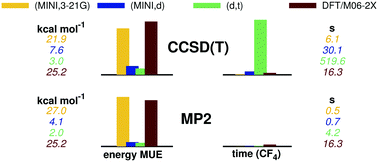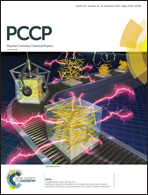CBS extrapolation in electronic structure pushed to the end: a revival of minimal and sub-minimal basis sets†
Abstract
The complete basis set (CBS) limit is secluded in calculations of electronic structure, and hence CBS extrapolation draws immediate attention. Of the highest importance is the extremely slow-convergent correlation energy as obtained both from Møller–Plesset perturbation theory (MP2) and the gold standard coupled cluster singles, doubles, and perturbative triples method [CCSD(T)], both picked as the focal point. Because today's massive electronic structure calculations demand schemes for CBS extrapolation from the lowest rungs of the hierarchical staircase, the focus is also on how minimal and subminimal basis sets can help in the endeavour. The above has prompted, for the first time, the development of a reliable analytic variant of the unified singlet- and triplet-pair extrapolation (USTE) scheme, which is next utilized to hierarchize any arbitrary basis set. With all available basis set families for molecular orbital calculations systematized as subminimal, minimal and extended from the fraction of correlation energy that they can recover, the full approach is simple and general, yet reliable, and hereby illustrated for basis sets as small as Huzinaga MINI and as extended as the sophisticated ansatzes that are utilized in modern explicitly correlated MP2-F12 and CCSD(T)-F12 calculations. Extensively tested with up to 26 basis sets from various families, the reported results show that CBS extrapolation from a (subminimal, extended) basis-set pair yields correlation energies that outperform by far those obtained from Kohn–Sham density functional theory (KS DFT). When employing two subminimal basis sets, the results may still outperform KS-DFT but at a drastically smaller computational cost. To further gauge its performance, the new method is utilized to calculate the energies of all 45 isomers of C8H8 recently reported at a high ab initio level, with the present results showing excellent agreement with the available data. The present cost-effective approach may therefore be expected to have a broad impact on chemistry and even materials science.



 Please wait while we load your content...
Please wait while we load your content...